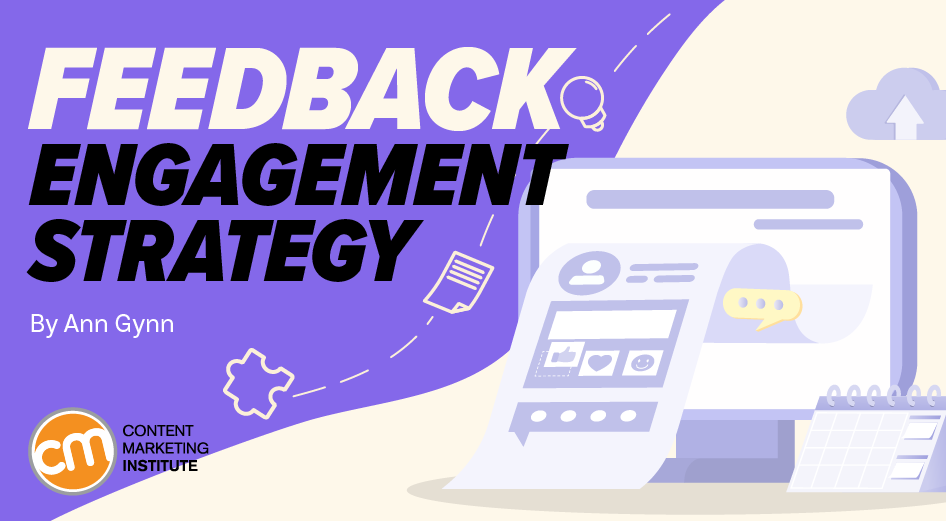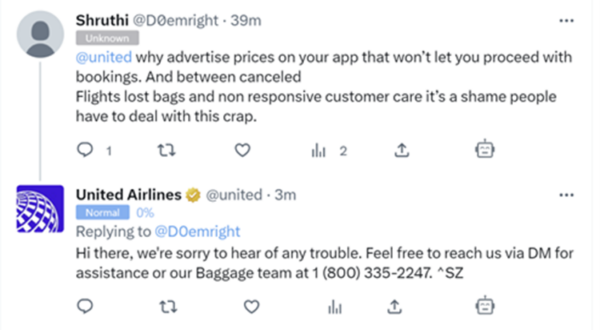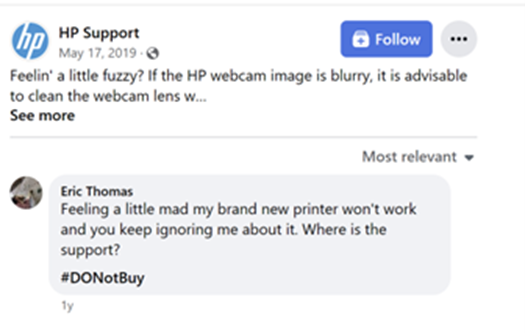MARKETING
Have a Feedback Strategy? You Better Because Your Audience Is Watching

Engagement metrics don’t tell the whole story.
A lot of B2B and B2C marketers – more than 75% – use engagement with email and websites to evaluate content’s impact. About three in four assess social analytics and their engagement metrics.
While engagement numbers work well as a measurement of interactivity, they don’t work as well to understand the person’s sentiment. That requires a qualitative assessment, and, more importantly, it often requires a qualitative response in real-time.
When audiences engage with your content and brand, your engagement with those reactions – their positive and negative feedback – can make a difference in how those people feel and think about your brand. And, when the feedback comes in a public forum, your response can make a difference in how digital bystanders view your brand.
Your brand’s response to feedback can make a difference in how critics and digital bystanders view your company, says @AnnGynn via @CMIContent. #SocialMedia Click To Tweet
That’s why you need a strategic feedback engagement system that all content marketing team members know and implement. Here are some ideas to help you create a successful plan:
View comments as invitations
Everybody wants to be heard. That’s why it’s so important to reply to comments on your social media or email messages to your company. You’re acknowledging that you saw and heard the message (and, ideally, the sentiment behind it).
Honeylove, a shapewear clothing brand, replies thoughtfully to every comment – positive, negative, or neutral – on its Facebook page. In this post, it tackles all three:
- After one person commented, “Love mine!!” The brand replied: “Thank you so much for taking the time to share your experience Irene Armstrong Field! We are absolutely thrilled that you love our garments as much as we do If there is anything you’d like to see from us in the future, let us know! We would love to hear from you ”
- When another person tagged a friend, the brand thanked them for sharing it.
- Someone else commented: “None of the women I’ve seen even have a weight problem.” That prickly statement might challenge some, but Honeylove was ready. They thanked her for the feedback and responded to correct her perceived criticism gently. They explained their size range (XS to 3X/4X). And said, “We have many posts with a diverse range of body types, all of whom look amazing in their Honeylove,” before sharing links to two videos that back up the statement. (The commenter thanked them for the thoughtful reply.)

All that interaction by the brand with the people who engaged with the brand’s Facebook content communicates to their audience that they value the interactions and are keenly interested in what their audience has to say. Taking the time to do that can have a bigger impact than just clicking “like” to indicate you read their post or, worse, doing nothing when people engage with the brand.
Taking the time to reply with more than a “like” lets your response have a bigger impact on the commenter and others, says @AnnGynn via @CMIContent. #SocialMedia Click To Tweet
TIP: Honeylove uses the commenter’s name in their reply. That personalization indicates to the commenter and other viewers that it’s not a formulaic, cut-and-paste response.
Listen, consider, research, act (or don’t)
Earlier this year, someone replied to CMI’s Monday newsletter from Kim Moutsos with a critique of her greeting: “Hi there.” To them, it sounded impersonal and snooty.
Now that’s an engagement victory – a real-life reply – even if the feedback wasn’t so positive. The subscriber mentioned they shared the opinion because Kim invites readers to share their feedback in every newsletter.
But now the question arose, what should she do with that feedback?
Kim replied to the critic. But she didn’t stop there. She started an internal conversation about the greeting’s appropriateness and possible alternatives. In her next weekly email, Kim shared the reader’s thoughts on the greeting and asked for more input. Others responded. Multiple conversations between CMI and individual readers – including the original commenter – ensued.
After all that, Kim still uses the greeting, “Hi there,” but she does so after taking the initial feedback seriously and learning upon further investigation that the constructive comment didn’t resonate with others.
Sometimes, feedback leads to a change. For example, a reader commented on the CMI blog that they found it hard to read because the related content boxes throughout the article disrupted the experience. After further consideration, CMI condensed the related content boxes into a single box and moved it to the end of each article.
Sabina Muminovic, content marketing manager at GenePlanet, guides their responses to feedback, particularly for reviews of their company on Trustpilot.
She maintains a list of relevant feedback and routinely reviews them with the product team to discuss solutions. “Why not use every opportunity to improve,” Sabina says. “Often, our customers see the forest we missed by looking too closely at the trees.”
Why not use feedback as an opportunity to improve? Often customers see the forest we missed by looking too closely at the trees, says Sabina Muminovic via @AnnGynn @CMIContent. #SocialMedia Click To Tweet
While GenePlanet takes a case-by-case approach to feedback now, it’s using that to distill the framework for a future company-wide policy.
Acknowledge the critics and haters
Of course, some members of the public can be mean and vicious in their feedback. They often don’t even use their names, hiding behind gobbledygook handles and email addresses.
In these cases, you can take two courses of action – reply to them or don’t. In most cases, I favor the reply, particularly if they gave the feedback in a public forum. Simple phrasing such as “Thank you for your comment” or “We have read your comment” should suffice. The reply doesn’t debate or challenge them. That just stirs the pot and gives them what they want – a reaction to which they can respond with more of what they said originally.
Of course, if they present factually incorrect information, your reply should include a credible source with the correct information: “Thank you for your comment. The (fact) is correct as shown in (add a link to a credible source).” After you post that, don’t respond to any subsequent conversation from the original poster, as it indicates to the audience that person deserves even more of your time.
Sabina says when a critic doesn’t accurately reflect their product or service because, for example, a user error was made, GenePlanet responds respectfully but clearly correcting the misperception.
“I believe such an approach strengthens the brand’s credibility and trustworthiness. It takes more time and requires really good copywriting, but it pays off,” Sabina says.
Now, some organizations might be regularly involved in subject matter that elicits frequent outcries from the public. If that’s your group, consider implementing a standard acknowledgment for all feedback – positive or negative, such as: “Thank you for sharing your thoughts with us.”
Move the conversation
Feedback on social media plays differently than it does in a direct email. Your audience can see the dialogue in real-time. When you find yourself replying back and forth with an individual on your social channels, consider what the airlines and other brands do on Twitter: Change the forum.
In this tweet, a customer tags United Airlines and complains about its advertised pricing promises, lost luggage, and non-responsive customer service, concluding, “It’s a shame people have to deal with this crap.” United responded with an apology and a request to contact them via direct message or by the phone number provided.

You end the public debate by inviting the critic to contact you directly. Even if the commenter never reaches out directly, your audience knows you tried.
HP Support made that mistake on Facebook when it left a negative comment sitting there for three years and counting without a supportive reply.

The post topic (how to fix a fuzzy HP webcam) isn’t what the commenter talked about (a new printer that won’t work and HP’s ignoring his support inquiries. However, it presented the perfect opportunity for HP Support to live up to its name, reply, and move to a one-on-one conversation. While Eric Thomas (the commenter) may never have been satisfied, I wouldn’t have seen HP’s lack of support confirmed three years later after a Google search delivered this content to help solve a problem with my webcam.
Make a feedback-response plan
Too often, brands and their digital teams make their replies to feedback on a case-by-case basis. But that can get you into trouble. Some team members may reply to all, and some may reply only to those asking questions. Audience members who do not get a response will feel slighted because others did get the courtesy of an acknowledgment from the brand.
To avoid all that, write a reply strategy. Detail when and how the team should respond to someone. For example, does it merit a simple acknowledgment, or should it start a conversation? You likely don’t have a one-reply-fits-all situation, so come up with a standard list of replies to the most frequently shared feedback. Next, set up a process so your team knows how to share the feedback with the departments to which it is relevant. Finally, establish guidelines for when the feedback recipient should escalate the internal conversation before they respond. Send a draft of the feedback-response plan to all the stakeholders for their input before you finalize the strategy.
By developing a deliberate feedback engagement strategy, your brand will benefit from both positive and negative engagement – and your audience will too.
HANDPICKED RELATED CONTENT:
Cover image by Joseph Kalinowski/Content Marketing Institute
MARKETING
The key to correcting the C-suite trust deficit

Take a moment to search “CMO tenure” and you’ll find a wide variety of content discussing the short tenure of CMOs and how it’s among the shortest of roles in the C-suite. If you dive deeper, you’ll find that CEOs don’t seem to trust CMOs.
Boathouse’s CMO Insights study (registration required) noted several sobering conclusions:
- 34% of CEOs have great confidence in their CMOs.
- 32% of CEOs trust their CMOs.
- 56% of CEOs believe their CMO supports their long-term vision.
- And only 10% of CEOs believe their CMO puts the CEO’s needs before their own.
If these statistics also apply to the CMO’s entire organization, then it’s clear we have a trust problem with marketing leadership.
If you haven’t read Patrick Lencioni’s “The Five Dysfunctions of a Team,” I consider it required reading for anyone in any leadership role. In his book, Lencioni builds a pyramid of dysfunctions that need to be addressed for a team to succeed. The foundational dysfunction — with which one cannot build a successful team — is “absence of trust.” We see it at scale with marketing organizations today.
Introducing objectivity through data
In “Hamlet,” Shakespeare writes, “There is nothing either good or bad, but thinking makes it so.” Each organization that makes up a company looks at the company from a different perspective. What marketing sees as positive, finance may see as negative. But who’s right? No one.
Usually, there is no objectivity because leadership comes up with an idea and we execute it. It’s like the fashion proverb “Beauty is in the eye of the beholder.” Unfortunately, we’re going to struggle to run a profitable organization if it’s run like a fashion show.
Therefore, we need to introduce objectivity to how we work. Leadership needs to come together to agree on goals that align with the goals of the broader organization. One element of this conversation should be an acknowledgment that this is turning a ship.
Often leaders — especially those without marketing backgrounds — are likely to expect instant gratification. It’s going to take time to turn the ship and you and your team would do well to set reasonable expectations right away.
Dig deeper: KPIs that connect: 5 metrics for marketing, sales and product alignment
Aligning goals and metrics across the organization
With goals in hand, we need to assign metrics to their progress and agree on the source(s) of truth. Once these objective measures are in place, perspective doesn’t matter. 2 + 2 = 4 regardless of whether you’re in HR or accounting.
Every public road has a speed limit and whether you’re in compliance with it has nothing to do with your perspective. If you’re above it, you’re wrong and subject to penalties. Referring to the fashion example, it’s not a fashion show where some people like a dress and others don’t.
By using data to objectively measure marketing’s progress within the organization and having the rest of the leadership buy into the strategy, we build trust through objectivity. Maybe the CEO would not have chosen the campaign the marketing team chose.
But if it was agreed that a >1 ROAS is how we measure a successful campaign, it can’t be argued that the campaign was unsuccessful if the ROAS was >1. In this example, the campaign was an objective success even if the CEO’s subjective opinion was negative.
Data-driven campaign planning
Within the marketing organization, campaigns should always be developed with measurement top of mind. Through analysis, we can determine what channels, creative, audiences and tactics will be most successful for a given campaign.
Being able to tell the leadership team that campaigns are chosen based on their ability to deliver measured results across metrics aligned to cross-departmental goals is a powerful message. It further builds trust and confidence that marketing isn’t run based on the CMO’s subjective opinions or gut decisions. Rather, it’s a collaborative, data-driven process.
For this to be successful, though, it can’t just be for show, where we make a gut decision and direct an analyst to go find data to back up our approach. This would be analytics theater, which is a perversion of the data. Instead, tell the analyst what you think you want to do and ask them to assess it.
For the rest of the organization’s leadership, ask questions when the marketing team presents a campaign. Find out how they came up with the strategy and expect to hear a lot about data — especially the metrics you all agreed would support the company’s overarching goals.
Dig deeper: 5 failure points of a marketing measurement plan — and how to fix them
Data literacy: Building credibility through transparency
Building trust doesn’t happen overnight, but a sustained practice of using data to drive marketing leadership’s decisions will build trust if the metrics ladder up to the organizational goals and all of leadership is bought into the measurement plan.
Over time, this trust will translate into longer tenure and more successful teams through building the infrastructure needed to tackle Lencioni’s five dysfunctions.
Opinions expressed in this article are those of the guest author and not necessarily MarTech. Staff authors are listed here.
MARKETING
How Tagging Strategies Transform Marketing Campaigns


As a marketer, I understand how today’s marketing campaigns face fierce competition. With so much content and ads competing for eyeballs, creating campaigns that stand out is no easy task.
That’s where strategies like tagging come in.
It helps you categorize and optimize your marketing efforts. It also helps your campaigns cut through the noise and reach the right audience.
To help you out, I’ve compiled nine ways brands use a tagging strategy to create an impactful marketing campaign.
Let’s get to it.
How Brands Use a Tagging Strategy
Tagging involves using keywords or labels to categorize and organize content, products, or customer data. You attach tags to specific items or information to make searching, sorting, and analyzing data easier.
There are various types of tags, including meta tags, analytics tags, image tags, hashtags, blog tags, and more.
So, how do brands use a tagging strategy to make their marketing campaigns stand out?
Improve Social Media Engagement
With over 5 billion users, social media provides an easy way to connect with your audience, build relationships, and promote your offerings.


Use a tagging strategy to boost social media interactions. Consistently use hashtags that align with current trends and topics. This encourages people to interact with your content and boosts content visibility.
You can also use tags to monitor brand mentions of your products or your industry. This allows you to engage with your audience promptly.
Consider virtual social media assistants to streamline your tagging strategy. These AI-driven tools can suggest relevant hashtags, track mentions, and automate responses. Implementing them can save time and resources while ensuring consistent engagement across your socials.
Build a Personal Brand on LinkedIn
LinkedIn is the world’s largest professional networking platform, with over 1 billion members across 200 nations. It offers excellent opportunities for individuals and businesses to build and nurture their brands.


However, simply creating a professional profile isn’t enough to build a personal brand on LinkedIn.
Use various tags to increase your visibility, establish thought leadership, showcase expertise, and attract the right connections. For instance, use skill tags to showcase your expertise and industry tags to attract connections and opportunities within your industry. Use certification tags to help showcase your expertise and credibility to potential employers or clients.
Facilitate Customer Segmentation and Personalization
Personalization matters—more so in today’s data-driven world. In fact, 65% of consumers expect your brand to adapt to their changing preferences and needs.
To meet this expectation, consider using a tagging strategy.
Segment your customers based on shared characteristics, such as demographics, interests, purchase history, cart abandonment, and behavior.
Here’s a summary of the steps to customer segmentation.


With your customer segments ready, use tags to tailor your marketing messages and offerings to specific segments. Imagine sending targeted email campaigns based on what your customers need. That’s the power of segmentation and tagging in action!
Enhance SEO and Content Discoverability
Tagging content can have a profound impact on search engine optimization (SEO) and content discoverability. When users search for specific topics or products, well-tagged content is more likely to appear in search results, driving organic traffic to your website.
Additionally, tags can help you analyze the most popular topics with your readers. Then, the results of this analysis can help you adjust your content strategies accordingly.
And get this— certain AI tools can help analyze your content and suggest relevant tags and keywords. Using these tools in addition to a tagging strategy can help optimize your SEO strategies and boost content discoverability.
Partner with the Right Influencers
Influencer marketing has become a go-to marketing approach for modern brands. Recent stats show that 85% of marketers and business owners believe influencer marketing is an effective marketing strategy.
But how do you find the perfect influencer for your campaign?
Utilize tags to identify influencers who are relevant to your niche. Beyond this, find influencers who align with your brand values and target audience.
Additionally, look for influencers who use hashtags that are relevant to your campaigns. For instance, fashion influencer Chiara Ferragni uses #adv (advertising) and #ghd (good hair day) hashtags in this campaign.


Monitor industry-specific hashtags and mentions to discover influential voices and build profitable relationships with them.
Track Hashtag Performance
Tracking your hashtag performance helps you understand your campaigns’ engagement, reach, and effectiveness.
To achieve this goal, assign special hashtags to each marketing project. This helps you see which hashtags generate the most engagement and reach, enabling you to refine your tagging strategy.
Here’s an example of a hashtag performance report for the #SuperBowl2024.


This curated list of hashtag generators by Attrock discusses the top tools for your consideration. You can analyze each and choose the one that best fits your needs.
Categorize Content Accordingly
The human attention span is shrinking. The last thing you want is for your audience to have difficulty in finding or navigating your content, get frustrated, and bounce.


Untagged content can be difficult to navigate and manage. As any marketer knows, content is important in digital marketing campaigns.
To categorize your content, identify the main categories by topics, themes, campaigns, target audiences, or product lines. Then, assign relevant tags based on the categories you’ve identified. After that, implement a consistent tagging strategy for existing and new content.
Organizing your content using tags can also help streamline your content management workflow. Most importantly, readers can easily find the content they’re looking for, thereby boosting overall user experience, engagement, and conversions.
Boost Your Email Marketing Strategy
Email marketing remains a powerful marketing tool in today’s digital world. It’s also another area where brands use a tagging strategy to directly reach their target audience.
Use tags to segment your email list and personalize your marketing messages. Then, you can send targeted emails based on factors like purchase history, interests, and demographics.
Personalization can significantly improve open rates, CTRs, and overall engagement and conversion rates. It’s a simple yet impactful strategy to make your email marketing strategy more effective.
Plus, you can use tags to track how well your emails perform with each group. This helps you understand what content resonates best with your audience and provides insight on how to improve your emails going forward.
Enhance Analytics and Reporting
Every marketer appreciates the immense value of data. For brands using tagging strategies, tags are powerful tools for gathering valuable data.
Analyze how users interact with your tagged content. See which tags generate the most clicks, shares, conversions, and other forms of engagement. Gain insight into audience preferences and campaign effectiveness.
This granular data about your marketing efforts allow you to make data-driven decisions, allocate resources effectively, and refine your marketing strategies.
Final Thoughts
There isn’t a single correct way for brands to use a tagging strategy in marketing. You can use a tagging strategy however you see fit. However, the bottom line is that this strategy offers you a simple yet powerful way to create attention-grabbing and unique marketing campaigns.
Fortunately, tagging strategies are useful across various marketing initiatives, from social media and email marketing to SEO and more.
So, if you’re ready to elevate your marketing campaign, build a strong brand presence, and stand out among the competition, consider employing effective tagging strategies today.
MARKETING
Tinuiti Recognized in Forrester Report for Media Management Excellence

Tinuiti, the largest independent full-funnel performance marketing agency, has been included in a recent Forrester Research report titled, “The Media Management Services Landscape, Q2 2024.” In an overview of 37 notable providers, this comprehensive report focuses on the value B2C marketing leaders can expect from a media management service provider, and analyzes key factors to consider when looking for a media management partner such as size and business scenarios. B2C marketing executives rely on media management services to:
- Augment the efficacy of media investments
- Bridge media impressions to commerce transactions
- Enhance ad campaigns to drive performance
Report authors, VP, Principal Analyst Jay Pattisall and Senior Analyst Nikhil Lai call attention to the pressing need for providers to prove their value, deliver profitable ROAS, and drive alignment between CMOs and CFOs and thus liberate strained marketing budgets.
Our Always-On Incrementality tool – which is a part of our patented tech, Bliss Point by Tinuiti – empowers marketers to validate the incrementality of their spend on each ad set, media channel, and marketing tactic so marketers can create stronger, more focused campaigns that get the job done without sacrificing the bottomline.
B2C marketing leaders often seek and expect key business scenarios from media management service providers including media measurement and attribution, data strategy, and marketing mix modeling. MMM’s adaptability to the post-cookie/ post-IDFA world positions it as an essential tool for marketers. As businesses seek to connect the dots, leverage data, and make strategic decisions, MMM is a crucial ally in the dynamic realm of mixed media advertising. Our Rapid Media Mix Modeling sets a new standard in the market with its exceptional speed, precision, and transparency.
According to the Forrester report, “46% of senior B2C marketing and advertising decision-makers say they plan to integrate performance and brand media assignments with a single media agency in the next 12 months…”
In our quest to better understand all revenue-driving aspects of a given campaign, we have started on a process to quantify the impact of Brand Equity, which we believe is one of the largest missing pieces in more accurate and complete measurement.
Learn more about Bliss Point by Tinuiti, our use cases, and our approach to performance and brand equity.
The Landscape report is available online to Forrester customers or for purchase here.
-
SEARCHENGINES7 days ago
Daily Search Forum Recap: April 29, 2024
-
SEARCHENGINES6 days ago
Daily Search Forum Recap: April 30, 2024
-

 MARKETING5 days ago
MARKETING5 days agoHow To Develop a Great Creative Brief and Get On-Target Content
-

 SEO7 days ago
SEO7 days agoGoogle’s John Mueller On Website Recovery After Core Updates
-

 WORDPRESS6 days ago
WORDPRESS6 days ago13 Best Fun WordPress Plugins You’re Missing Out On
-

 SEO5 days ago
SEO5 days agoWhy Big Companies Make Bad Content
-

 SEO5 days ago
SEO5 days agoHow To Drive Pipeline With A Silo-Free Strategy
-

 SEO6 days ago
SEO6 days agoOpenAI To Show Content & Links In Response To Queries
















